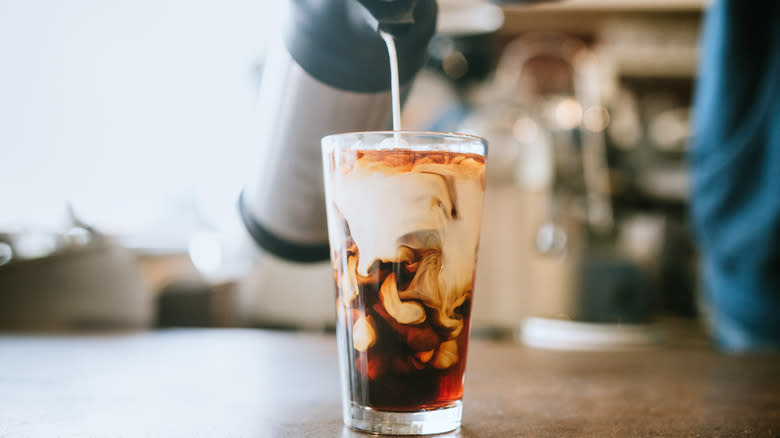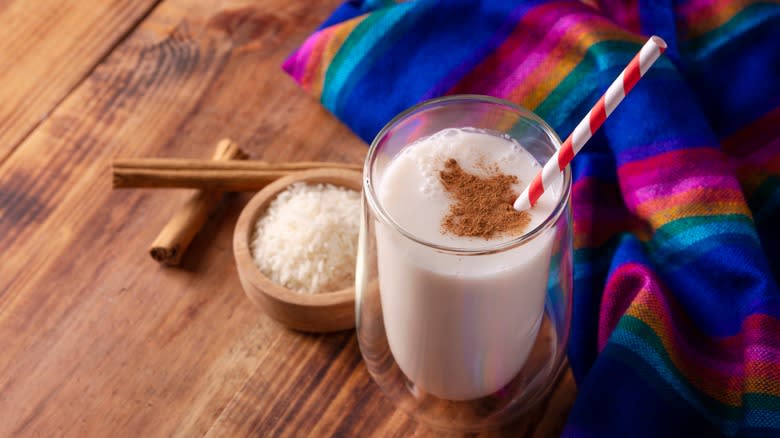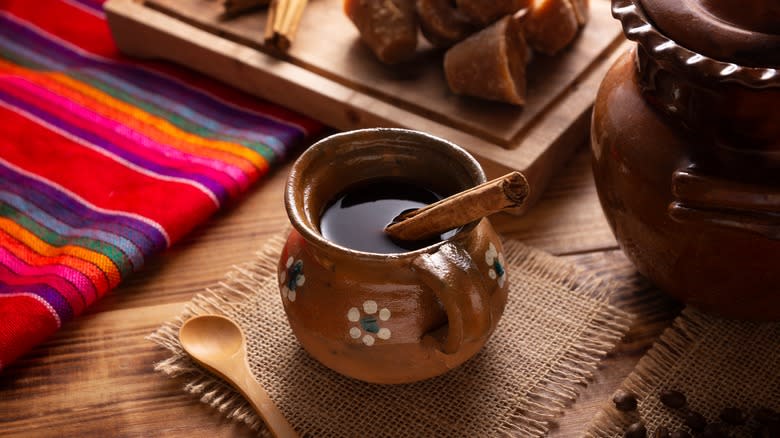Add Horchata To Your Coffee For A Rich, Delicious Kick

There are few things in life more precious than a mutual benefit society, and this extends to the culinary arts every bit as much as human interactions. The "two great tastes that taste great together" phenomenon can occasionally lead to not only a marvelous combination but a whole that is greater than the sum of its parts. To that end, it's worth considering the idea of adding the slightly thick, lightly sweet, completely delicious drink that is horchata to your next cup of coffee in lieu of creamer. The various aspects of complementary flavors from each will interlock like gears, producing a result that will make you pause after one sip at least long enough to whisper a heartfelt "wow."
Why all the fuss? For starters, the opportunity to combine two typically discrete food items is often a potential source of delight. For too long, different coffee drinks have been relegated to some version of dairy, be it half and half, steamed milk, or ice cream. Horchata might be non-dairy, but it's no slouch in the creaminess department. Moreover, it brings a cinnamon essence to the party that already exists as a Mexican coffee tradition. In other words, what are you waiting for?
Read more: The 15 Best Milk Brands, Ranked
What Is Horchata?

Horchata is a creamy, non-dairy, drink that sometimes is made with herbs, rice, seeds, or nuts, along with other ingredients. While it originated in Southern Spain -- where it's made with tiger nuts -- horchata has spread to almost every Spanish-speaking region. In Ecuador, it's made exclusively with flowers and herbs, and Puerto Ricans make their horchata with sesame seeds. But, for the purposes of this article at least, coffee pairs well with the best-known version (at least to Americans): Mexican horchata, which is typically made with rice, sugar, and cinnamon.
For something made from so few ingredients, Mexican horchata can be sublime. In fact, Mexican horchata is so popular that many forms of it are commercially available. You can buy it online or from a variety of retail chains in liquid form, as an instant powder, or in concentrate. Having said that, it's a simple matter to make a batch of horchata at home.
Like Goes With Like And We Like That

If you need a proof of concept, there are plenty of horchata coffees commercially available -- either flavored whole beans or pre-made drinks. Grabbing one is as easy as going to the store. But if you feel like you've already got a good coffee game going at home and want to try a novel brew, then consider these possibilities: an horchata Americano, made with one or two espresso shots, or an iced horchata cold brew that would really hit the spot. Horchata's creaminess perfectly offsets the robustness of coffee made in a French press, just as it would suit your everyday pour-over in lieu of your usual half-and-half or oat creamer. Consider doing so a little reward.
If you're feeling downright artisanal, and are already planning on making your own bespoke horchata, consider pairing it with native Mexican coffee. There are three internationally known coffee-producing regions in Mexico, each with its own flavor profile: Chiapas, Veracruz, and Oaxaca. The first two tend to grow bright, high-acidity coffee beans; Chiapas being more citrusy, and Veracruz more spicy. Coffee grown in Oaxaca, by contrast, has fairly low acidity and more pronounced sweetness -- though to be fair, Mexican coffee beans that are properly roasted are never bitter. Coffee drinks made from these beans are not unlike a good mole, boasting flavors of chocolate, nuts, and fruit. Combining any brew made from these beans with homemade horchata will surely be a match made in heaven.
Read the original article on Daily Meal.

